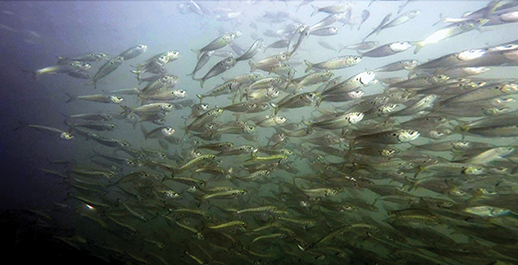Efforts to ratchet down fishing effort on species like herring and menhaden in the name of “extra precautionary management” in most cases are unlikely to bring additional benefits for stocks of predator species that eat them, according to a new study.
“Our results indicate that predator productivity was rarely influenced by the abundance of their forage fish prey,” wrote authors Christopher Free of the University of California-Santa Barbara, Olaf Jensen of the University of Wisconsin-Madison, Ray Hilborn of the University of Washington. “Only 6 predator populations (13 percent of the total) were positively influenced by increasing prey abundance and the model exhibited high power to detect prey influences when they existed,” according to their paper titled “Evaluating impacts of forage fish abundance on marine predators,” originally published in the journal Conservation Biology.
“These results suggest that additional limitation of forage fish harvest to levels well below sustainable yields would rarely result in detectable increases in marine predator populations.”
The findings were released July 6 through the Science Center for Marine Fisheries, a cooperative effort to improve sustainability of fisheries and reduce uncertainty in biomass estimates with work by university partners led with the University of Southern Mississippi Virginia Institute of Marine Science, College of William and Mary, as academic sites.
“Our work suggests that the sustainable limits that we already employ are sufficient for maintaining forage fish abundance above the thresholds that are necessary for their predators,” Free of UC Santa Barbara in a statement describing the findings. “Predators are highly mobile, they have high diet flexibility, and they can go and look for forage fish in places where they’re doing well, switch species for species that are doing well, and have often evolved to breed in places where there’s high and stable forage fish abundance.”
The researchers used models incorporating data on 45 predator species, including fish, seabirds and marine mammals, and adding environmental factors. According to the models those other factors, such as water temperature, “are more likely to influence predator populations. These results are consistent with previous efforts to examine the relationship between predator and prey populations.”
Data sets going back to the 1950s and 1960s on predator populations were tapped from five regions around the world along with records of forage fisheries, Free said in a video presentation on the findings.
“We were able to link up these two data sets to ask the question: How has prey abundance influenced the population growth of these predators around the world?” he said.
“What we’ve done here that’s different from previous analyses is try to control for some of the other factors that influence predator population dynamics,” said Jensen of the University of Wisconsin. “In this case, we included in the models a covariate representing ocean temperature.”
The paper contributes to ongoing debates in U.S. fisheries management over how tightly to regulate fish at the lower end of the trophic scale that feed larger, more commercially valuable and recreationally sought fish, and protected species including whales and other marine mammals.
“The study finds that, at least in forage fisheries that are already being well managed and are closely monitored, adopting additional precautionary measures will ‘rarely’ provide any additional benefits to predator population growth,” according to the Science Center for Marine Fisheries assessment. “However, fishery managers who deal with less well-monitored fisheries may consider more precautionary strategies.”
“In places of the world where we already have really strong, very effective fisheries management, additional limitations on forage fish catch are not likely to benefit their predators,” said Free.
“Management of forage fish populations should be based on data that are specific to that forage fish, and to their predators,” said Jensen. “When there aren’t sufficient data to conduct a population-specific analysis, it’s reasonable to manage forage fish populations for maximum sustainable yield, as we would other fish populations under the Magnuson-Stevens Act.”
“No one has seriously suggested that overfishing forage species is a good idea,” said Jensen. However, the study suggests that in nations with good management systems, those stocks could be fished at closer to their maximum sustainable yields without negatively affecting predator species, he said.
The are still caveats to looking at those results, said scientist Eva Plaganyi of the Australian government’s CSIRO Oceans and Atmosphere agency, in video commentary on the paper.
For example, “if you are fishing near the breeding colony” of a predator species dependent on forage fish, forcing those animals to travel father and expend more energy in pursuit of food could have an impact on their success, said Plaganyi: “I think it is very case-specific.”







